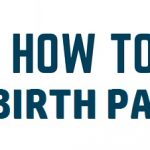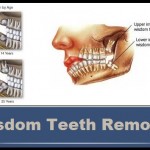How Many Teeth Do Adults Have ?
Function: The primary function of the teeth in humans is to cut and crush the food material into small pieces to aid better digestion and assimilation. There are broadly four kinds of teeth in humans, the canines, the incisors, the premolars and the molars together forming the full range of 32 teeth found in an adult human. Each of the different kinds of teeth does a very specialized job such that no two can be interchanged. The canines tear the food, the incisors cut the food into smaller particles, the premolars and the molars together does the function of crushing the food. Each tooth is embedded in the upper or lower jaws and is covered by the gums. The teeth are one of the most hardy features of the human species and is found in two types. The milk teeth and the permanent teeth.
The Anatomy of a Teeth: At the very outermost layer is the crown, the part that functions as the contact during chewing. This crown is principally made of dentine and is a hardy and non-wearing part of the teeth. Protected by the crown is the soft inner fleshy layer, the pulp of the teeth. Like the crown, the part of the teeth that is within the gums is the root and is covered by the cementum. This cementum, is a lesser tougher material than the crown, but just as well serves the purpose of shielding the inner pulp and is composed of dentine.
The root most times would branch out into two or three, except for the canines and the incisors that have only a single root. It is the root of the teeth that holds the teeth in the socket. The lower portion of the root accommodates the blood vessels that serve to keep the teeth nourished and alive. The enamel the hardest part of the tooth is visible normally and is supported by the underlying dentine. This outer layer varies in color from grayish white to a pale yellow. This semi translucent dentine would allow the lower layers to show through giving color to the teeth. Composed of mainly minerals the dentine is very brittle by nature.
Dentin is what is found between the tooth pulp and the outer enamel. Composed of mainly minerals, the dentin serves as a cushion to the tooth and is secreted by the pulp of the teeth. Being softer than the enamel, it is succeptable to decay and must be protected by the outer enamel at all times. With porous tubules radiating outward the dentin is a transitional layer that keeps the pulp and the crown together. The dentine, when exposed tend to give a sensational feel or a sharp pain to the person.
The pulp of the tooth is the central part that covers the inner core of the tooth. Comprising of a network of capillaries and soft tissue, this is a living and growing part of the tooth. Nourishment is had from the blood vessels that come into the pulp at the same time the pulp, keeps the enamel and dentin healthy and growing.
The Development of Teeth: Through a complex process that involves the multiplication and the replacement of the cells, the tooth development takes place. For human teeth to develop healthy, this must start at the very early stages in the fetal stages. Any disruption in this early stage of tooth development would mean the inability to have good healthy teeth. Tooth development has been divided into the four stages, the bud, the cap, the bell stage and finally the maturation. Being a complex development, the progress in each section has not been that thoroughly defined.
The first of the baby teeth is set to appear a few months after birth and would keep erupting till the age of four. The set of permanent teeth starts erupting at typically the age of six onwards and will go throughout puberty and into the adult life. The molars, the wisdom tooth, appearing when into the twentieth year. Learn more about wisdom teeth and its removal here.
Tooth eruption is when the baby tooth is finally visible or at times just felt in the mouth. This is brought about by a combination of factors that bring into fruition the complex processes involved with the development of the teeth in humans. The first signs that a tooth is due is felt by the person, later is the top of the tooth visible to the outside. While the very first set of teeth in humans is meant to last a few years, the later occurring set of teeth, the permanent teeth, is to last the person the rest of his life time.
Tooth Decay: Plaque and caries decide on how many teeth do adults have. Not seen to discriminate between the ages, the two enemies of good teeth, plaque and caries do indeed decide the health of your teeth. Plaque is a thin bio film of bacteria that cover the tooth outer layer and consists of a multitude of bacteria. Frequent removal of this bio film does indeed help maintain good teeth. If left to itself the plaque would produce acids to melt away the outer enamel coating of the teeth, forming cavities. The yellow hard deposits, tartar is had with the buildup of plaque. Frequent and a good brushing does indeed keep plaque at bay. The composition and severity of plaque formation are decided by the person’s food habits rather than anything else.
Caries is the softening of the tooth enamel to allow the pulp to be exposed to the food material. The outcome of this activity would be the loss of teeth in a person. Each individual has his own tolerance levels of caries. Some people, no matter how hard they try, can’t simply keep caries at bay. A tooth severely infected by caries can indeed be repaired, with the extreme treatment of root canal filling a painful and unpleasant experience.
Care for your teeth: Giving good care to your teeth does go a long way in deciding how many teeth do adults have. Regular brushing along with dental flossing does keep plaque and caries at bay. Most dentists do indeed recommend that the person brushes twice a day. This practice if adopted early could help the person keep healthy teeth for years on end. It is advisable to pay regular visits to the dentist to do a thorough cleaning, removing tartar and deposits that would have built up over time.
The importance of brushing twice a day cannot be emphasized enough. This removes plaque before it develops into tartar. Also, any early signs of tooth decay are picked up early and can be attended to in its early stages. Dental flossing must be followed to remove the plaque buildup at the gum line. If possible, try and use a fluoridated toothpaste as it helps toughen the dentine, hence preventing tooth decay and disease. Spend two or three minutes each time that you take to brush your teeth, making a good job of it. Limit the acidic natured drinks like aerated and soft drinks; this only causes an acidic build up in the mouth, causing the erosion of tooth enamel and hence causes cavities. Sugary food items can only aid the plaque buildup by the bacteria in the mouth.
People taking part in sports should wear protective gear to cover their teeth as it will directly impact how many teeth do adults have. A good helmet or face guard does prevent physical damage to the teeth during these times. Avoid opening of bottle caps and other such unhealthy habits. This does only damage your teeth. And to cap it all pay regular visits to the dentist as any issue can be picked up very early in its development.
Overcoming tooth decay: If the worst were to come, then there is no other way out than to have a dental restoration. Teeth that are left uncared for and mostly teeth that do have a genetic tendency to decay does need to be taken care of restoratorily. Here a visit to the dentist is mandatory. The dentist would advise on the best available solution to how many teeth do adults have. Modern day dentistry does ensure keeping the decayed teeth to the maximum with the best available solutions to prevent tooth loss. Dental implant too are the order of the day, giving the client the most favorable of solutions available.
Saliva: A much ignored item in oral health has been often the role of the Saliva in the oral cavity. The Saliva prevents unhealthy build up acidic or harmful natured pH in the mouth. It acts as a buffer solution that keeps the mouth clean and lubricated. The initial stages of digestion start with the saliva. Plaque buildup is limited by the active intervention of the saliva and is the first line in protecting the enamel of the teeth.
A complete oral health program is incomplete without the mention of substances like cigarettes and alcohol consumption. These substances do indeed aid in the deterioration of the teeth health. Regular health checkup must be done even with healthy teeth as it will decide on how many teeth do adults have. Caries thus, can be detected at the very early start, when the damage would have been minimal. Despite the advances in medical sciences, there has never been a replacement to teeth that could match; let alone beat the natural teeth, in function and appearance.




